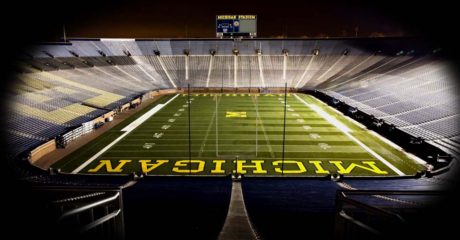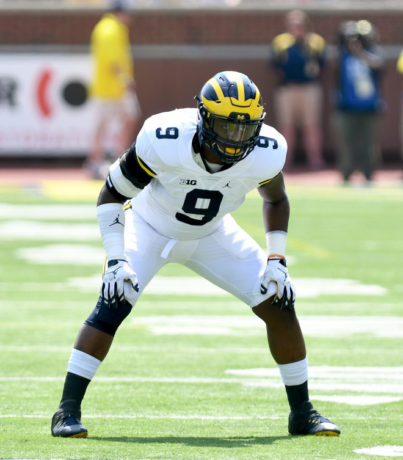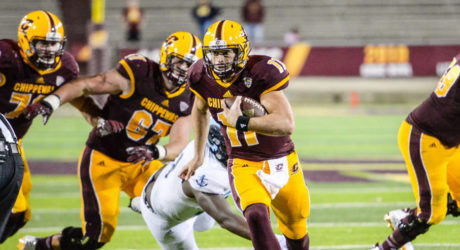
Henry Poggi (image via Freep)
HIGH SCHOOL
Poggi committed to Michigan in January of 2012 as a part of the 2013 class (LINK). I gave him a final TTB Rating of 79 (LINK). He played defensive tackle at Baltimore (MD) Gilman, where the head coach was his father, Biff. The elder Poggi liked Michigan’s coaching staff at the time (Brady Hoke and Co.), and he eventually came to work at Michigan as a staffer under Jim Harbaugh before returning to coach Baltimore (MD) St. Frances. The younger Poggi was an Under Armour All-American at defensive tackle, and he fended off advances from Alabama late in the recruiting process to stick with his Michigan pledge. Ironically, Alabama wanted him as an H-back, and Michigan fans thought that was funny because he was a defensive lineman all the way. And then . . .
COLLEGE
Poggi redshirted in 2013, as expected. As a backup defensive tackle in 2014, he made 2 tackles. Then Hoke was fired, and in came Jim Harbaugh, who flipped Poggi to H-back. He started four games during the 2015 season, making 1 catch for 2 yards and generally struggling as a blocker. However, his blocking improved in subsequent seasons. He had 1 carry for 4 yards and 6 catches for 45 yards in 2016. And in his final year, he had a 2-yard touchdown run against Maryland, his home-state team, and he caught 2 passes for 21 yards on the year.
CAREER STATS
4 tackles
2 carries for 6 yards (3.0 yards/carry) and 1 touchdown
9 catches for 68 yards (7.6 yards/catch)
AWARDS
Robert P. Ufer Bequest for enthusiasm (2017)
SUMMARY
Poggi’s career was somewhat unexceptional, especially when looking back and seeing that he was an Under Armour All-American and recruited hard by Alabama. One would expect that a high school All-American would turn into a high-quality player in college, and that never seemed to be the case. He was a little-used backup defensive lineman early in his career, and Jim Harbaugh needed a big, bruising fullback to run his offense when he arrived in 2015. If he had stayed on the defensive line, there’s a good chance that he would have turned out to be a good defensive player, because that’s what Greg Mattison does with defensive linemen. He never seemed to fit the mold of a true fullback for Michigan, though, at 6’4″ and 257 lbs. Early in his career, he had difficulty identifying which defender to block and trouble with the technique of getting the job done. And while that eventually improved, he was never a dual-threat guy to hurt teams with the ball in his hands. Fellow position-switcher Khalid Hill always seemed more effective, and Poggi took playing time away from Hill. And looking at it from Poggi’s perspective, I wonder if Michigan really handcuffed his chances of getting to the NFL by moving him to offense.
I WILL REMEMBER HIM FOR . . .
. . . being an awkward fit at fullback. I’m down with occasionally moving a guy like William Carr or Refrigerator Perry to running back/fullback on the goal line, but playing a 6’4″, 257 lb. defensive lineman at fullback for three years seems like an odd move. Poggi played fine and it’s not really a knock on him, but it’s just a rarity in college football.
PROJECTION
As I mentioned above, I wonder if the move to fullback was a death knell for his opportunity at an NFL career. NFL teams generally keep approximately one fullback on the roster, and they are also rarely of the 6’4″, 257 lb. variety. Poggi has very little experience blocking as an in-line tight end, and he probably doesn’t have the athleticism to be an NFL H-back. While there was a lot of competition for playing time on the defensive line at Michigan, that would have fit his body type better, and he would have received the full Greg Mattison Effect that has sent the likes of Ryan Glasgow, Willie Henry, and others (who were higher rated) on to NFL careers. I don’t see Poggi getting drafted, and I don’t really envision him having a long career as a free agent.





